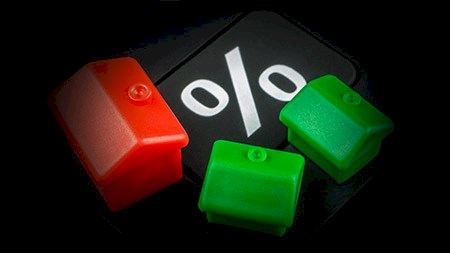Jacques du Toit, Senior Property Economist of the Absa Group looks at the advantages and disadvantages of fixed versus variable interest rates and the factors that would influence the decision to fix the rate or not.
Interest rates were recently increased in South Africa, for the first time since September 2002. This caused the cost of servicing debt, especially mortgage debt, to increase. As a result of this development and consumers' experience in the past regarding rising interest rates, it is appropriate to consider issues such as the difference between fixed and variable rates, the advantages and disadvantages of fixed and variable rates and whether or not to fix the interest rate on a mortgage at this point in time.
The difference between fixed and variable mortgage rates
Fixed mortgage rate
A fixed mortgage rate agreement is a legally binding contract between a financial institution and a client that guarantees a fixed rate of interest over a pre-determined period. The agreement may not be terminated prior to the expiry of the contracted term of the agreement. The implication of withdrawing from the contract before the expiry date is the payment of a penalty fee, which is stipulated in the agreement.
Currently, South African commercial banks offer clients fixed mortgage rates for periods of 12, 18 or 24 months. The level of the fixed rate varies according to the period over which it is fixed, as well as the loan amount and the loan-to-value ratio.
Variable mortgage rate
Commercial banks' variable lending rates to the public normally fluctuate in line with the central bank's key policy interest rate. Adjustments to South African commercial banks' variable lending rates (the prime and mortgage rates) normally take place after the Monetary Policy Committee (MPC) of the South African Reserve Bank (SARB) has announced a change to its key policy interest rate, the repurchase (repo) rate.
Although this has not always been the case in the past, the current convention among the South African commercial banks is to adjust their variable lending rates by the same margin as the adjustment in the repo rate. As a result, the margin between the repo rate and variable lending rates such as the prime and mortgage rates has remained stable at 3,5 percentage points since the late 1990s.
The advantages and disadvantages of fixed and variable mortgage rates
Fixed mortgage rate
Advantages: A fixed mortgage rate will not increase when other interest rates rise. This gives peace of mind with regard to future mortgage repayments. It allows the client to plan and budget more accurately and facilitates future cash flow management. Clients may revert to the variable rate after the fixed-rate contract has expired, or may decide on a new fixed-rate contract, depending on their personal financial circumstances and views of the future interest rate cycle.
Disadvantages: A fixed mortgage rate may well be above the variable rate for the full term of the fixed-rate contract. The gap between fixed and variables rates may widen if variable rates fall during the term of a fixed-rate contract. Clients are locked in for the full term of a fixed-rate contract.
Variable mortgage rate
Advantages: Clients get the immediate and full benefit of a cut in interest rates, while they may at any time switch to a fixed-rate contract in an attempt to hedge interest rate risk. Under certain conditions and terms, clients may gain a rate concession (negotiate a mortgage rate lower than the prevailing variable rate, depending on certain terms and conditions).
Disadvantages: Clients feel the immediate and full impact of any increase in interest rates. Sharp increases in interest rates may affect clients' ability to repay mortgage loans to such an extent that the financial institution has no other option but to repossess the properties concerned because instalments are not being paid. However, this is normally the last option, as such actions benefit neither the client nor the financial institution.
The various options currently available with regard to fixed and variable mortgage rates have increased the flexibility of managing the repayments on a mortgage loan to a large extent. Clients can take market conditions and interest rate expectations into account in their choice of a mortgage rate.
Whether or not to fix a mortgage rate
The decision whether or not to fix the interest rate on a mortgage loan will depend on the following factors:
Macroeconomic conditions and their possible impact on the interest rate cycle. Factors such as inflationary pressures, growth in credit extension, the level of household debt, currency movements, and the condition of the balance of payments (which will depend on the balance on the current account and capital flows) may influence the central bank's monetary policy stance (the direction of interest rates, as well as the magnitude and duration of interest rate adjustments).
Consumers' personal financial circumstances. Interest rates may be at a historical low at any given point in time, but if consumers have the view that rates will increase for any reason in the near future, they may elect to switch to a fixed rate, especially if they have a fixed level of income and strict control over cash flow is important to them.
Timing. The timing of the decision to fix a mortgage rate can be of great importance. The best time to fix an interest rate is as near as possible to the time when rates are expected to start increasing (the bottom of the interest rate cycle). If rates are expected to increase only in twelve months time, it may be expensive to fix the rate too early at a level that is above the variable rate at the time. However, if you wait too long before fixing your mortgage rate and interest rates increase, the eventual fixed rate may be higher than what you would have paid if you fixed the rate at a somewhat earlier stage.
Mortgage interest rate trends and developments
During 1998, when the prime interest rate was hiked to a record level of 25,5% and variable mortgage interest rates increased to 23,5%, fixed-rate mortgages became more common in South Africa. This development gave huge support to many households that were struggling with significantly higher debt repayments, helping them to survive the adverse effects of extremely high-interest rates at the time.
Inflationary pressures currently present in the economy, high growth in credit extension and household debt, as well as a deteriorating current account on the balance of payments, prompted the SARB to lift the repo rate by 50 basis points to 7,5% in June this year. As a result, commercial banks increased their prime lending and variable mortgage rates by the same margin to 11% shortly afterwards.
It is at times like these that many consumers, in view of their debt commitments, become uncertain about the future trend and level of interest rates and consider reverting to a fixed rate on their mortgage loans in an attempt to minimise the risk of sharply higher interest rates.
Because financial institutions have to take most of the risk of fixed-rate mortgages, as well as the history with regard to interest rate fluctuations in South Africa, the maximum period over which a fixed rate on a mortgage loan is offered by South African commercial banks is 24 months.
However, households are also required to take on some of the risks by having to pay a higher fixed rate than the prevailing variable rate, depending on the loan amount, the loan-to-value ratio and the period of the fixed-rate contract. See table presenting Absa's fixed mortgage interest rates.
Current projections are for domestic interest rates to increase somewhat further over the next twelve months, but to remain low by historical standards.
To summarise, fixed and variable mortgage interest rates have both advantages and disadvantages. The decision to fix or not to fix rests entirely with consumers. This decision will depend on consumers' personal financial position, trends and developments regarding various macroeconomic and other external factors which may impact on interest rates and, ultimately, consumers' view of the timing, magnitude and frequency of future interest rate adjustments. Consumers' decisions will also be influenced by expectations regarding the duration of any upward or downward adjustment in interest rates.






